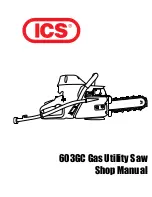
www.scheppach.com
28 | GB
e) Never cross your hand over the intended line of
cutting either in front or behind the saw blade.
Supporting the workpiece “cross handed” i.e. hold-
ing the workpiece to the right of the saw blade with
your left hand or vice versa is very dangerous.
f) Do not reach behind the fence with either hand
closer than 100 mm from either side of the saw
blade, to remove wood scraps, or for any other
reason while the blade is spinning.
The prox-
imity of the spinning saw blade to your hand may
not be obvious and you may be seriously injured.
g) Inspect your workpiece before cutting. If the
workpiece is bowed or warped, clamp it with
the outside bowed face toward the fence.
Always make certain that there is no gap be-
tween the workpiece, fence and table along
the line of the cut.
Bent or warped workpieces
can twist or shift and may cause binding on the
spinning saw blade while cutting. There should be
no nails or foreign objects in the workpiece.
h) Do not use the saw until the table is clear of all
tools, wood scraps, etc., except for the work-
piece.
Small debris or loose pieces of wood or
other objects that contact the revolving blade can
be thrown with high speed.
i) Cut only one workpiece at a time.
Stacked multiple
workpieces cannot be adequately clamped or braced
and may bind on the blade or shift during cutting.
j) Ensure the mitre saw is mounted or placed on
a level, firm work surface before use.
A level
and firm work surface reduces the risk of the mitre
saw becoming unstable.
k) Plan your work. Every time you change the
bevel or mitre angle setting, make sure the ad-
justable fence is set correctly to support the
workpiece and will not interfere with the blade
or the guarding system.
Without turning the tool
“ON” and with no workpiece on the table, move
the saw blade through a complete simulated cut
to assure there will be no interference or danger of
cutting the fence.
l) Provide adequate support such as table exten-
sions, saw horses, etc. for a workpiece that is
wider or longer than the table top.
Workpiec-
es longer or wider than the mitre saw table can
tip if not securely supported. If the cut-off piece
or workpiece tips, it can lift the lower guard or be
thrown by the spinning blade.
h)
Keep handles and grasping surfaces dry,
clean and free from oil and grease.
Slippery handles and grasping surfaces do not
allow for safe handling and control of the tool in
unexpected situations.
5. Service
a)
Have your power tool serviced by a qualified
repair person using only identical replacement
parts.
This will ensure that the safety of the power
tool is maintained.
m
WARNING!
This electric tool generates an electro-
magnetic field during operation. This field can impair
active or passive medical implants under certain con-
ditions. In order to prevent the risk of serious or deadly
injuries, we recommend that persons with medical im-
plants consult with their physician and the manufacturer
of the medical implant prior to operating the electric tool.
Safety instructions for mitre saws
a) Mitre saws are intended to cut wood or wood-
like products, they cannot be used with abra-
sive cut-off wheels for cutting ferrous material
such as bars, rods, studs, etc.
Abrasive dust
causes moving parts such as the lower guard to
jam. Sparks from abrasive cutting will burn the
lower guard, the kerf insert and other plastic parts.
b) Use clamps to support the workpiece when-
ever possible. If supporting the workpiece by
hand, you must always keep your hand at least
100 mm from either side of the saw blade. Do
not use this saw to cut pieces that are too small
to be securely clamped or held by hand.
If your
hand is placed too close to the saw blade, there is
an increased risk of injury from blade contact.
c) The workpiece must be stationary and clamped
or held against both the fence and the table. Do
not feed the workpiece into the blade or cut “free-
hand” in any way.
Unrestrained or moving workpiec-
es could be thrown at high speeds, causing injury.
d) Push the saw through the workpiece. Do not
pull the saw through the workpiece. To make
a cut, raise the saw head and pull it out over
the workpiece without cutting, start the mo-
tor, press the saw head down and push the
saw through the workpiece.
Cutting on the pull
stroke is likely to cause the saw blade to climb on
top of the workpiece and violently throw the blade
assembly towards the operator.
Содержание 5901218901
Страница 113: ...www scheppach com 113...
Страница 114: ...www scheppach com 114 HM1247...
















































